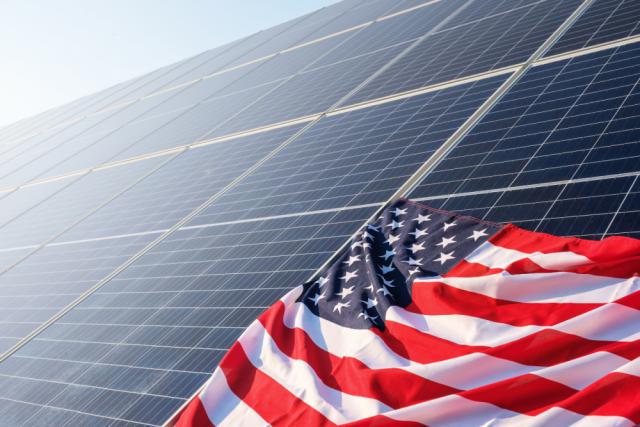
The U.S. solar industry has been suffering as supply chain bottlenecks brought some projects to a standstill. (Source: Shutterstock.com)
U.S. President Joe Biden’s move this week to waive tariffs on solar panels from four Southeast Asian countries for two years amid an ongoing probe brought some relief to the solar industry, but clouds haven’t cleared completely.
Uncertainty surrounding U.S. antidumping and countervailing duties (AD/CVD) continues to plague the industry during times when it feels as if everything that could go wrong has gone wrong, as Wood Mackenzie’s global solar research head Xiaojing Sun put it during the company’s solar summit this week. The most prominent challenge, she said, is the supply chain.
“Think about the past decade. Solar is the shining example of how renewable has become affordable. It gives people hope for the first time that renewable can become mainstream,” Sun said. “But I feel like in the past couple of months, solar is taking on a different role. It has become this canary in the coal mine of the U.S. renewable energy sector. … U.S. solar builders spend at least 50% more to procure solar modules compared to their Western counterparts like developers in Germany or Australia. And if this threat of AD/CDV materializes, even with low 40% rates, it’s still going to push solar modules to a level that we haven’t seen in a decade.”
“I feel like in the past couple of months, solar is taking on a different role. It has become this canary in the coal mine of the U.S. renewable energy sector.”—Xiaojing Sun, Head of Solar, Wood Mackenzie
Like others, Sun called this week’s announcement from the White House good news, noting it also provides some clarity on wafers.
“Relief is on the way. I think it’s definitely good news, but at Wood Mackenzie we’re still cautiously following the news and trying to understand more details,” she said, turning turn some of the unknowns. Will the executive order face legal challenges? Will the executive orders materialize?
Earlier this week, President Joe Biden waived tariffs on solar panels from Cambodia, Malaysia, Thailand and Vietnam for two years and invoked the Defense Production Act to give domestic solar panel manufacturing a boost and expand manufacturing of electrolyzers, heat pumps, insulation and transformers.
The move, which was a hot topic for discussion during sessions at Wood Mackenzie’s Solar & Energy Storage Summit in California this week, came after the Department of Commerce began an anti-dumping circumvention investigation in March. It took aim at Chinese polysilicon PV manufacturers that were possibly routing supply chains through nearby countries to get around U.S. solar panel tariffs imposed during the Trump administration. The investigation stemmed from a February complaint by California-based Auxin Solar.
Coping
The industry has been suffering as supply chain bottlenecks brought some projects to a standstill.
“We’ve lost essentially two to four months of imports from the Southeast Asian countries, and that’s had a real impact,” varying by project, said Sean Gallagher, vice president of state and regulatory affairs for the Solar Energy Industries Association.
“We’ve lost essentially two to four months of imports from the Southeast Asian countries, and that’s had a real impact.”—Sean Gallagher, vice president of state and regulatory affairs, Solar Energy Industries Association
Some developers had access to panels; some weren’t so lucky.
“There are other projects that we’re planning to mobilize this year, mobilized construction and have demobilized that construction,” Gallagher said, noting some projects with acres upon acres of installed posts with no modules. “We’ve seen significant delay of projects from 2022 into 2023, and I think also some from ‘23 to ‘24.”
The hits have been felt across the country.
Colorado saw about 400 MW of lost capacity value between the delayed solar and delayed storage for summer 2023 peak demand, said Eric Blank, chairman of the Colorado Public Utilities Commission.
“Our balancing authority is about 8,000 megawatts. So, off a 16% planning reserve margin, we’re losing, maybe 35% of our reserve. So, it’s a hit to resource adequacy.”
Speaking during a different session, Sun pointed out that the utility scale solar sector—once the bright spot of the U.S. solar sector—has been hit the hardest by antidumping and countervailing duties.
“Off a 16% planning reserve margin, we’re losing, maybe 35% of our reserve. So, it’s a hit to resource adequacy.”—Eric Blank, Chairman, Colorado Public Utilities Commission
“They beared the brunt of the impact here [with a] 49% decline of installation in 2022 compared to 2021,” she said, adding it is expected to bounce back next year. “There’s really hope. I would say really strong hope for where the U.S. solar industry is heading, assuming we navigate through the short-term policy challenges.”
The headwinds have even caused regulators in some states to question whether they should extend the lives of gas or coal plants, panelists said. Northern Indiana Public Service Co., for example, in May cited the investigation on solar tariffs and market uncertainty for the delayed retirement of two of its coal-fired generating facilities until 2025.
“Obviously, [Monday’s] statements are going to relieve a lot of that, but that's been a real question,” Gallagher said.
Waiting
The president’s latest actions mean the industry doesn’t have to worry about AD/CDV duties from Cambodia, Malaysia, Thailand and Vietnam. No retroactive tariffs will be applied.
The investigation, however, has not stopped.
The Department of Commerce is obligated to reach a decision and the outcome will be applied, barring some other kind of action, said Garrett Nilsen, acting director for the U.S. Department of Energy’s Solar Energy Technologies Office.
“Ultimately, at the end of the day, Congress does still hold the power of the purse.”—Garrett Nilsen, Solar Energy Technologies Office Director (Acting), U.S. Department of Energy
The tariff relief also doesn’t stop the Uyghur Forced Labor Protection Act, which is set to take effect June 21, he said. The law puts importation limits on goods produced using forced labor in China’s Xinjiang Uyghur Autonomous Region.
While the president mobilized the Defense Production Act to spur development in the solar sector, more action is also needed to move forward. Facilities can be manufactured, assets procured and systems installed with the DPA. “However, every one of those three things cost money. And ultimately, at the end of the day, Congress does still hold the power of the purse,” Nilsen said, adding the Biden administration has been working closely with Congress to how to drive appropriations.
Industry players seem hopeful, given their efforts have received support from both sides of the aisle.
Clean energy, solar and storage should be bipartisan issues, Gallagher said. “The advanced manufacturing initiatives that are in the bill should appeal to Democrats and Republicans alike. The job creation that solar and storage means or will lead to should be appealing to Democrats or Republicans alike,” he said. “We think that the prospects remain pretty strong for clean energy progress.”
Reuters reported this week that the investigation, announced in late March, could take 150 days or more to complete. The investigation prompted 19 state governors, 22 U.S. senators and dozens of other legislators to write to Biden.
Recommended Reading
CERAWeek: Exxon Mobil CEO Says Not Trying to Acquire Hess
2024-03-18 - CEO Darren Woods said Exxon Mobil is trying to secure preemption rights over Hess Corp.'s Guyana assets in its dispute with Chevron, not buy the company itself.
California Resources Corp., Aera Energy to Combine in $2.1B Merger
2024-02-07 - The announced combination between California Resources and Aera Energy comes one year after Exxon and Shell closed the sale of Aera to a German asset manager for $4 billion.
Ecopetrol, Occidental Permian JV Generating Positive Results
2024-03-07 - Ecopetrol SA's joint venture with Occidental Petroleum in the Permian continues to generate outstanding operational and financial results for the Colombian state-owned energy giant.
Making Bank: Top 10 Oil and Gas Dealmakers in North America
2024-02-29 - MergerLinks ranks the key dealmakers behind the U.S. biggest M&A transactions of 2023.
EnQuest Selling Stake in North Sea Golden Eagle Oilfield, Sources Say
2024-04-16 - EnQuest has struggled in recent years with high debt levels and a drop in profits after Britain imposed a 35% windfall tax on North Sea producers.




